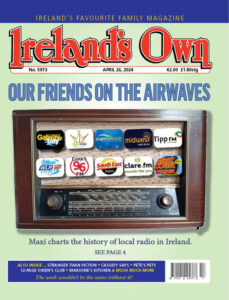Maxi charts the history of local radio in Ireland and talks to some of the people who were involved in it from very early on, while Jack Tomkins quizzes Alan Corcoran on what it’s like to be a local radio presenter.
‘Marconi used to live there; he’s the man who made the world shrink ’
I am walking in the grounds of RTÉ when one of the security staff, on his rounds, noticed I had stopped in front of a large house. He chatted with me as we walked. ‘In order to appreciate radio and local radio especially,’ he tells me in his distinctive melodious Arklow accent, ‘one has to go back to the beginning’. So! Let’s do that.
 It all began with Guglielmo Marconi. The former resident of that stately home in Donnybrook, who died in 1937, was an Italian whose name will forever be associated with the invention of radio, telegrams and wireless communications. His vision of the future leaped from his time to ours. He was interested in long distance radio transmissions.
It all began with Guglielmo Marconi. The former resident of that stately home in Donnybrook, who died in 1937, was an Italian whose name will forever be associated with the invention of radio, telegrams and wireless communications. His vision of the future leaped from his time to ours. He was interested in long distance radio transmissions.
Radio used to be those ubiquitous boxes in every room of our homes; now we simply listen on our phones. This was part of his vision. What Marconi invented was the idea of global communications, or, more simply, globally networked mobile wireless communications. He was the first to develop a system using a newly-discovered electromagnetic radio spectrum. He had an unflinching, self-confident vision of technology.
Ireland played a pivotal role in his early work experiments. In 1898 he set up a link between Rathlin Island and Ballycastle. Clifden was also important in Irish broadcasting history. It was the location of the first transatlantic wireless telegraphy service. Because of Marconi, a message could be sent across the Atlantic between Clifden and Grace Bay Nova Scotia, over a century ago.
In 1916, during the Easter Rising, a Morse Code message from the rebels in the General Post Office in 1916 is on record as the first broadcast.
In 1925, 2RN was set up to make its first transmission. It was later renamed Radio Éireann. That national station led to an appetite for community radio, the illegal but hugely popular pirate radio, independent radio, local radio and finally pan-local radio.
From the moment the first national station came into being there was an appetite for nearby and national news, but it was many years before the Independent Radio and Television Commission explored the ever expanding market. The big debate – National Interest versus Local Interest – began as Radio Éireann was the only choice. It wasn’t long before the audience called for diversity.
So, the young took the matter into their own hands and pirate radio became the go-to frequency to hear local bands and items of interest.
Continue reading in this week’s Ireland’s Own


